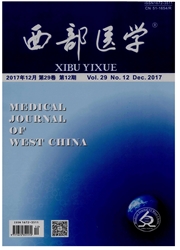

 中文摘要:
中文摘要:
目的 探讨HLA-A,-B,-DRB1单倍型与抗癫痫药物(AEDs)引发皮肤不良反应(cADRs)的关系.方法 本研究一共纳入74例cADRs[包括13例患有Steven-Johnson综合征(SJS)和中毒性表皮坏死松解症(TEN)]的癫痫患者、70例对AEDs耐受的癫痫患者和71名健康对照者.HLA基因分型采用的是polymerase chain reaction (PCR)-sequence-based-typing(SBT)法.结果 通过基因分型检测,一共发现27个HLA-A、46个HLA-B和33个HLA-DRB1等位基因.4个高频出现的单倍型为:HLA-A* 3303-B* 5801-DRB1* 0301,HLA-A* 0207-B* 4601-DRB1* 0901,HLA-A* 3001-B* 1302-DRB1* 0701和HLA-A* 1101-B* 1502-DRB1* 1202.基于整个人群分析,单倍型HLA-A*3303-B* 5801-DRB1* 0301在耐受AEDs的癫痫患者中出现的频率(10/70)高于在AEDs诱发皮疹的癫痫患者中出现的频率(3/74),差异有统计学意义(P<0.05).2例耐受AEDs的患者携带了单倍型HLA-A* 1101-B* 1502-DRB1*1202.健康对照与AEDs诱发皮疹的癫痫患者之间差异无统计学意义(P>0.05).在AEDs引发的重症皮疹(SJS和/或TEN)患者中,有7例患者携带单倍型HLA-A* 1101-B* 1502-DRB1*1202和HLA-A* 1101-B* 1502-DRB1*1501,并且这7例患者均服用卡马西平(CBZ).CBZ-cADRs的患者与CBZ耐受及健康对照组相比,上述两个单倍型的分布差异均具有统计学意义(均P<0.05).结论 单体型HLA-A* 3303-B* 5801-DRB1* 0301可能是保护性基因因素之一.在中国大陆癫痫患者中,单倍型HLA-A* 1101-B* 1502-DRB1*1202和HLA-A* 1101-B* 1502-DRB1*1501与AEDs诱发皮疹的发生有极大的关系.
 英文摘要:
英文摘要:
Objective This study aimd to investigate the association between antiepileptic drugs (AEDs)-induced cutaneous adverse drug reactions (cADRs) and human leukocyte antigen (HLA)-A, -B, -DRB1 in patients from mainland of China. Methods 74 patients with cADRs, including 13 with Stevens-Johnson syndrome (SJS), and toxic epidermal necrolysis (TEN), 70 AEDs -tolerant controls and 71 healthy volunteers were recruited. HLA genotyping was performed by the polymerase chain reaction (PCR)-sequence-base&typing (SBT) method. Results 27 HLA-A, 46 HLA-B and 33 HLA-DRB1 alleles were detected in genotyping. 4 high frequency haplotypes were reconstructed: HLA-A * 3303-B * 5801-DRB1 * 0301, HLA-A* 0207-B* 4601-DRB1 * 0901, HLA-A* 3001-B* 1302-DRB1 * 0701, HLA-A * ll01-B * 1502-DRB1 * 1202. The former one was found with higher percentage (10/70) among AEDs-tolerant controls than cADRs patients (3/74) with statistic significance (P~0.05) in whole enrolled population. Two of those tolerant controls also took haplotype HLA-A ~ 1101-B * 1502-DRB1 * 1202. No similar phenomenon was found in healthy volunteer and cADRs groups, even among patients with SJS/TEN. The latter and other haplotype HLA-A * 1101-B * 1502 DRB1 * 1501 was merely found in seven different patients, who exactly had carbamazepin (CBZ)-induced SJS/TEN, in all patients with severe cADRs, both with significant difference in the frequency comparing with CBZ-tolerant controls and healthy volunteers (P〈0.05). Conclusion these data suggested that haplotype HLA-A* 3303-B* 5801-DRB1 * 0301 might be one of the protective genetic factors for AEDs-induced cADRs. HLA-A ~ 1101-B ~ 1502-DRB1 ~ 1202 and HLA-A ~ 1101-B ~ 1502-DRB1 ~ 1501 had strong association with CBZ-induced SJS/TEN among patients from mainland of China.
 同期刊论文项目
同期刊论文项目
 同项目期刊论文
同项目期刊论文
 Predictive markers for carbamazepine and lamotrigine-induced maculopapular exanthema in Han Chinese.
Predictive markers for carbamazepine and lamotrigine-induced maculopapular exanthema in Han Chinese. Genetic susceptibility to the cross-reactivity of aromatic antiepileptic drugs-induced cutaneous adv
Genetic susceptibility to the cross-reactivity of aromatic antiepileptic drugs-induced cutaneous adv 期刊信息
期刊信息
